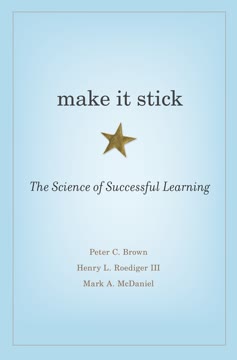Key Takeaways
1. Learning is misunderstood: Effective strategies are often counterintuitive
Empirical research into how we learn and remember shows that much of what we take for gospel about how to learn turns out to be largely wasted effort.
Common misconceptions. Many people believe that rereading material, cramming before exams, and focusing on one topic at a time are effective learning strategies. However, research shows these methods are often ineffective for long-term retention and understanding.
Counterintuitive strategies. The most effective learning techniques are often not intuitive:
- Retrieval practice (self-testing)
- Spaced repetition
- Interleaving different topics
- Introducing desirable difficulties
Benefits of evidence-based techniques. These strategies lead to:
- Deeper understanding
- Better long-term retention
- Improved ability to apply knowledge in new contexts
- Enhanced problem-solving skills
2. Retrieval practice strengthens memory more than rereading
Repeated effortful recall or practice helps integrate learning into mental models, in which a set of interrelated ideas or a sequence of motor skills are fused into a meaningful whole that can be adapted and applied in later settings.
Testing effect. Actively recalling information through self-quizzing or practice tests strengthens memory more effectively than passive rereading. This phenomenon is known as the "testing effect" or "retrieval practice effect."
How it works:
- Retrieval reinforces neural pathways
- Identifies gaps in knowledge
- Improves long-term retention
- Enhances ability to apply information in new contexts
Practical applications:
- Use flashcards
- Take practice tests
- Explain concepts to others
- Write summaries from memory
3. Spaced and interleaved practice leads to better long-term retention
When practice conditions are varied or retrieval is interleaved with the practice of other material, we increase our abilities of discrimination and induction and the versatility with which we can apply the learning in new settings at a later date.
Spacing effect. Distributing practice sessions over time leads to better long-term retention than massed practice (cramming). This allows time for consolidation and strengthens memory traces.
Interleaving. Mixing different topics or types of problems during practice sessions improves:
- Ability to discriminate between concepts
- Transfer of knowledge to new situations
- Overall understanding of relationships between ideas
Examples:
- Alternating between different types of math problems
- Practicing various sports skills in a mixed order
- Studying related but distinct historical periods in one session
4. Embrace difficulties: Effortful learning changes the brain
Difficulties that you can overcome with greater cognitive effort will more than repay you in the depth and durability of your learning.
Desirable difficulties. Introducing challenges during learning can lead to stronger, more durable memories and deeper understanding. These difficulties require more effort but result in better long-term outcomes.
Types of desirable difficulties:
- Generation (attempting to solve problems before being taught the solution)
- Reflection (analyzing and elaborating on learned material)
- Calibration (aligning judgments of knowledge with objective feedback)
Neuroplasticity. Effortful learning leads to physical changes in the brain, creating new neural connections and strengthening existing ones. This process enhances cognitive abilities and problem-solving skills over time.
5. Avoid illusions of knowing: Test yourself to gauge true understanding
Fluency with a text has two strikes against it: it is a misleading indicator of what you have learned, and it creates the false impression that you will remember the material.
Metacognition. Accurately assessing what you know and don't know is crucial for effective learning. Many people overestimate their understanding due to illusions of knowing.
Common illusions:
- Familiarity with material mistaken for mastery
- Confusing ease of processing with depth of understanding
- Hindsight bias (feeling that you "knew it all along")
Strategies to combat illusions:
- Regular self-testing
- Seeking objective feedback
- Explaining concepts to others
- Applying knowledge in new contexts
6. Move beyond learning styles: Focus on effective learning strategies
We are not persuaded that you learn better when the manner of instruction fits those preferences. Yet there are other kinds of differences in how people learn that do matter.
Learning styles myth. Despite popularity, there's little scientific evidence supporting the idea that matching instruction to preferred learning styles (e.g., visual, auditory, kinesthetic) improves learning outcomes.
What matters more:
- Using evidence-based learning strategies
- Developing metacognitive skills
- Building mental models and connections between ideas
- Practicing retrieval and application of knowledge
Alternative approaches:
- Focus on learning strategies that work for all learners
- Adapt teaching methods to the content, not individual preferences
- Encourage students to develop a range of learning skills
7. Increase your abilities through deliberate practice and growth mindset
Whatever the field, expert performance is thought to be garnered through the slow acquisition of a larger number of increasingly complex patterns, patterns that are used to store knowledge about which actions to take in a vast vocabulary of different situations.
Deliberate practice. Achieving expertise requires focused, effortful practice aimed at improving specific aspects of performance. This involves:
- Setting clear goals
- Obtaining immediate feedback
- Constantly pushing beyond comfort zones
Growth mindset. Believing that abilities can be developed through effort and practice leads to greater resilience and achievement. This contrasts with a fixed mindset, which sees abilities as innate and unchangeable.
Developing expertise:
- Break down complex skills into component parts
- Practice with increasing difficulty and complexity
- Seek feedback and adjust accordingly
- Embrace challenges and learn from failures
8. Make it stick: Apply proven learning techniques in various settings
The techniques for highly effective learning that are outlined in this book can be put to use right now everywhere learners, teachers, and trainers are at work.
Classroom applications:
- Incorporate frequent low-stakes quizzing
- Use cumulative testing to reinforce past material
- Encourage students to generate explanations
- Provide opportunities for spaced and interleaved practice
Workplace training:
- Implement simulation-based learning
- Use scenario-based assessments
- Encourage reflection and peer teaching
- Design training programs with spaced repetition
Self-directed learning:
- Develop a habit of self-quizzing
- Create a spaced repetition schedule
- Seek out challenges and novel applications of knowledge
- Regularly reflect on learning experiences and adjust strategies
By applying these evidence-based techniques across various learning environments, individuals and organizations can significantly improve the effectiveness and durability of learning outcomes.
Last updated:
FAQ
What's Make It Stick: The Science of Successful Learning about?
- Focus on Learning Science: The book delves into the science of learning and memory, offering evidence-based strategies for effective learning.
- Counterintuitive Strategies: It presents strategies that may seem counterintuitive, like embracing difficulties and using retrieval practice, which lead to deeper learning.
- Real-Life Examples: Through stories and examples, the authors illustrate successful application of these principles in various fields.
Why should I read Make It Stick: The Science of Successful Learning?
- Improve Learning Effectiveness: The book helps you adopt effective learning strategies grounded in cognitive science for better retention.
- Debunking Myths: It challenges common beliefs about learning, such as the effectiveness of cramming and learning styles.
- Applicable to All Learners: Whether you're a student, teacher, or lifelong learner, the insights can enhance your learning processes.
What are the key takeaways of Make It Stick: The Science of Successful Learning?
- Effortful Learning is Better: Learning is deeper and more durable when it requires effort, as easy learning often leads to quick forgetting.
- Retrieval Practice is Crucial: Actively recalling information strengthens memory and interrupts forgetting, making testing a powerful tool.
- Spaced and Interleaved Practice: Spacing out practice and mixing topics leads to better retention and understanding.
What are the best quotes from Make It Stick: The Science of Successful Learning and what do they mean?
- "Mastery is a quest": True mastery requires effort and persistence, not just passive learning, encouraging readers to embrace challenges.
- "The harder it is to recall": Struggling with recall strengthens memory, suggesting that difficulties can lead to deeper understanding.
- "Knowledge is not knowhow": This underscores the difference between rote memorization and true understanding, encouraging focus on concepts.
What is retrieval practice, and why is it important in Make It Stick: The Science of Successful Learning?
- Definition of Retrieval Practice: It involves recalling information from memory, strengthening neural pathways associated with that information.
- Benefits of Retrieval: Engaging in retrieval practice reinforces learning and improves long-term retention.
- Practical Applications: Techniques like self-testing and flashcards are effective forms of retrieval practice.
How does spacing out practice improve learning according to Make It Stick: The Science of Successful Learning?
- Concept of Spaced Practice: It involves distributing learning sessions over time rather than cramming all at once.
- Long-Term Retention: Spacing out practice strengthens memory and improves retention over the long term.
- Real-World Examples: Examples like surgical residents performing better with spaced lessons demonstrate its effectiveness.
How does interleaved practice improve learning in Make It Stick: The Science of Successful Learning?
- Definition of Interleaved Practice: It involves mixing different topics or types of problems during study sessions.
- Benefits of Interleaving: This method enhances learning by forcing adaptation and better discrimination between concepts.
- Contrast with Massed Practice: Massed practice leads to quick gains but poor long-term retention, unlike interleaving.
What are "desirable difficulties" in Make It Stick: The Science of Successful Learning and how do they enhance learning?
- Definition of Desirable Difficulties: Challenges that make learning harder but lead to stronger retention and understanding.
- Examples of Desirable Difficulties: Techniques like spacing, interleaving, and retrieval practice create these beneficial challenges.
- Long-Term Benefits: Embracing these difficulties encourages deeper processing and more durable learning outcomes.
How do cognitive biases affect learning and self-assessment in Make It Stick: The Science of Successful Learning?
- Understanding Cognitive Biases: Biases can lead to overconfidence and misjudgments about what we know.
- Illusions of Mastery: Learners often mistake familiarity with material for true understanding, leading to poor self-assessment.
- Importance of Feedback: Seeking feedback and engaging in self-testing can counteract these biases and improve self-awareness.
What role does reflection play in the learning process according to Make It Stick: The Science of Successful Learning?
- Definition of Reflection: Involves reviewing and thinking critically about what has been learned to enhance understanding.
- Benefits of Reflective Practice: Helps connect new knowledge to prior experiences and solidify understanding.
- Practical Techniques: Writing summaries or discussing key concepts with peers can facilitate reflection and deepen learning.
How can I apply the principles from Make It Stick: The Science of Successful Learning in my own learning?
- Implement Retrieval Practice: Use self-testing techniques like flashcards to reinforce learning and improve retention.
- Incorporate Spacing and Interleaving: Space out study sessions and mix different subjects to enhance understanding.
- Embrace Challenges: View difficult material as opportunities for growth and deeper learning.
What is the difference between rule learners and example learners in Make It Stick: The Science of Successful Learning?
- Rule Learners: Focus on understanding underlying principles, better at applying knowledge to new situations.
- Example Learners: Tend to memorize specific examples without grasping broader rules, hindering problem-solving.
- Improving Example Learning: Comparing multiple examples helps identify commonalities and extract underlying rules.
Review Summary
Make It Stick offers evidence-based strategies for effective learning, emphasizing retrieval practice, spaced repetition, and interleaving over traditional methods like rereading. The book challenges common misconceptions about learning and provides practical techniques for students, teachers, and lifelong learners. While some readers find the content repetitive or overly long, many praise its insights and applicability. The authors stress the importance of effortful learning, embracing difficulties, and developing a growth mindset. Overall, reviewers recommend the book for its valuable advice on improving memory retention and learning efficiency.
Similar Books










Download PDF
Download EPUB
.epub digital book format is ideal for reading ebooks on phones, tablets, and e-readers.




